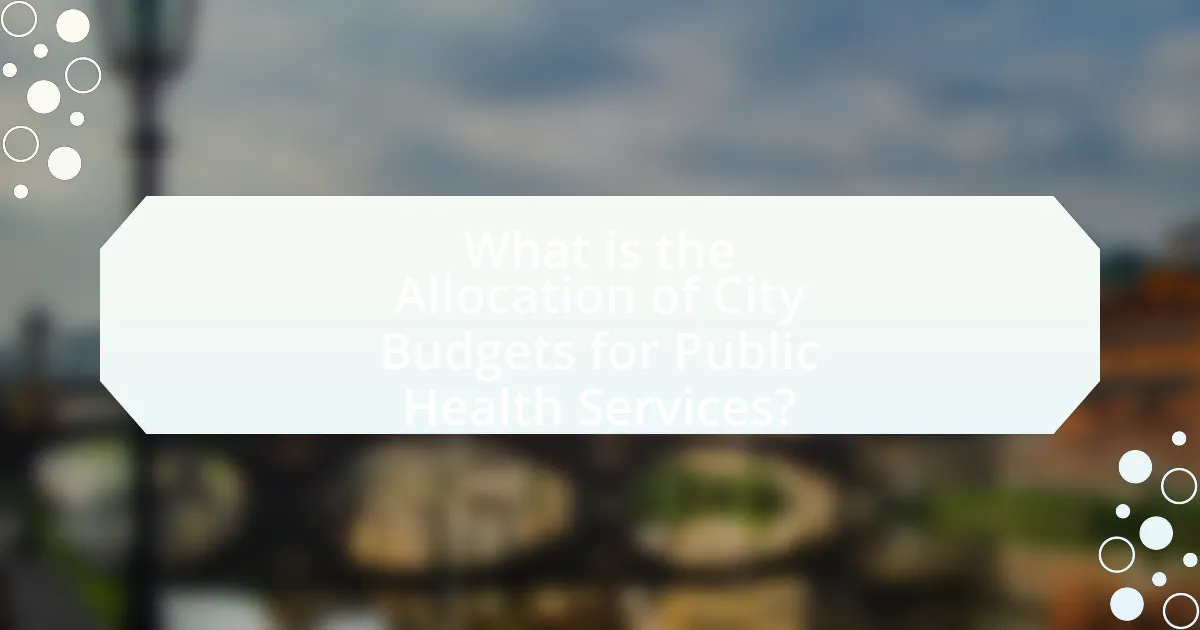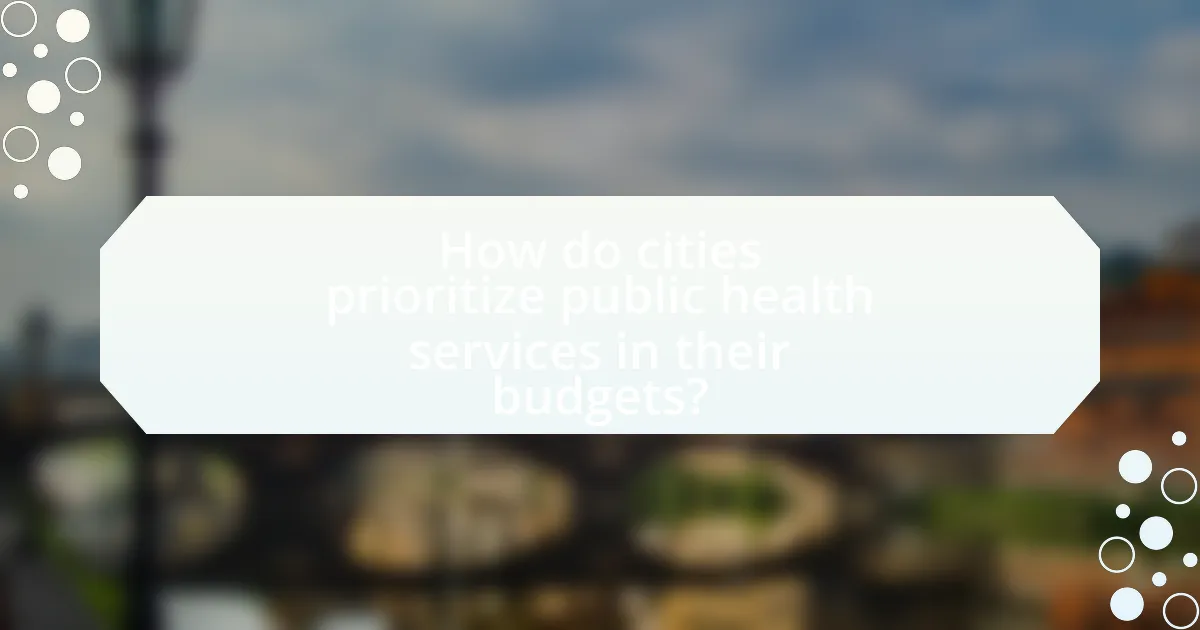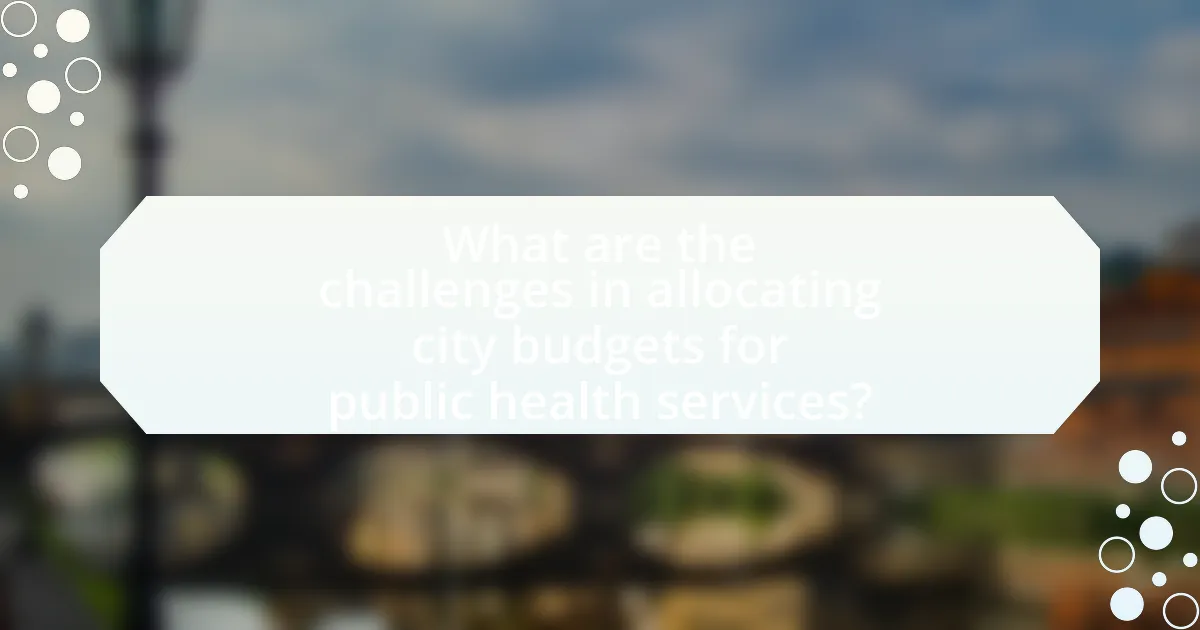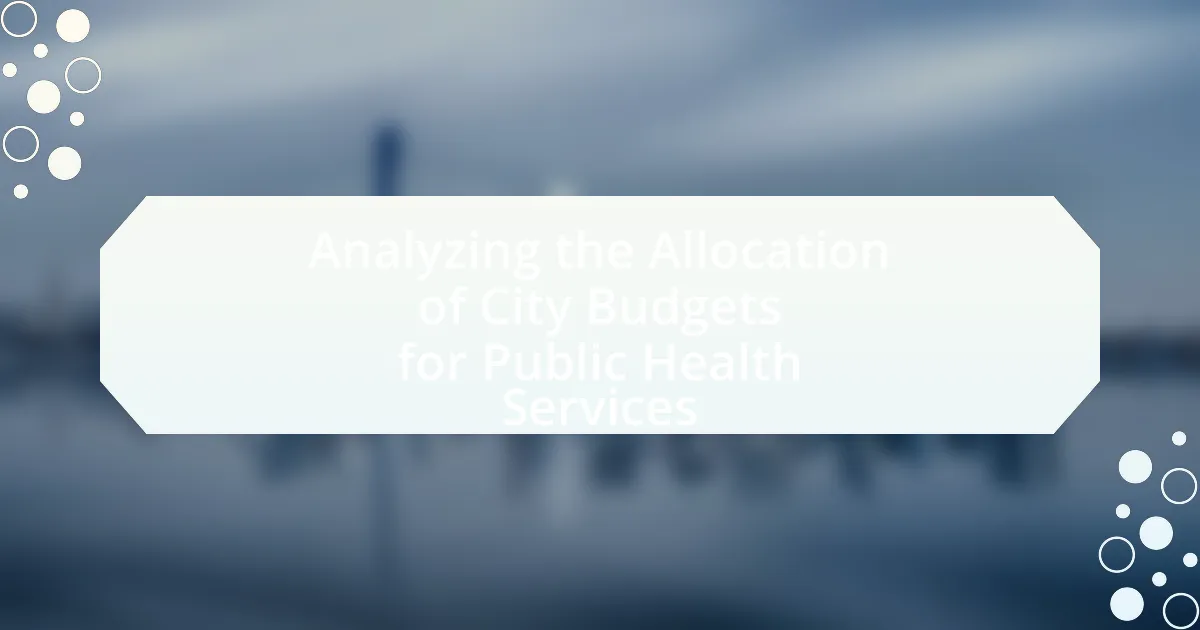The article focuses on the allocation of city budgets for public health services, highlighting the varying percentages allocated by different cities, such as 10% in San Francisco and around 5% in smaller cities. It examines the importance of budget allocation in addressing health disparities, funding preventive care, and responding to public health emergencies. Key factors influencing budget decisions include population health needs, funding availability, and stakeholder interests. The article also discusses the impact of budget allocations on the quality of public health services, the challenges cities face in funding these initiatives, and future trends in public health budgeting, emphasizing the role of data-driven decision-making and community engagement in optimizing resource allocation.

What is the Allocation of City Budgets for Public Health Services?
City budgets for public health services typically allocate a percentage of the overall budget, which can vary significantly by city. For example, in 2021, cities like San Francisco allocated approximately 10% of their total budget to public health, while smaller cities may allocate around 5%. This funding supports various health initiatives, including disease prevention, health education, and emergency response services. The allocation is often influenced by factors such as population health needs, local health disparities, and available federal or state funding.
Why is the allocation of city budgets important for public health services?
The allocation of city budgets is crucial for public health services because it directly determines the resources available for health initiatives, infrastructure, and personnel. Effective budget allocation enables cities to address health disparities, fund preventive care programs, and respond to public health emergencies. For instance, the Centers for Disease Control and Prevention (CDC) emphasizes that cities with well-funded public health departments can better manage outbreaks and improve community health outcomes. Additionally, a study by the National Association of County and City Health Officials found that increased funding correlates with improved health metrics, such as reduced rates of chronic diseases and better access to healthcare services.
What factors influence the allocation decisions for public health services?
Allocation decisions for public health services are influenced by factors such as population health needs, funding availability, policy priorities, and demographic trends. Population health needs drive resource distribution to address specific health issues prevalent in communities, while funding availability determines the extent of services that can be provided. Policy priorities set by government agencies and stakeholders shape the focus areas for public health initiatives, and demographic trends, including age, income, and ethnicity, inform the specific health challenges faced by different groups. For instance, a study by the World Health Organization highlights that cities with higher rates of chronic diseases allocate more resources to preventive health services to mitigate these issues.
How do city budgets impact the quality of public health services?
City budgets significantly impact the quality of public health services by determining the funding available for health programs, facilities, and personnel. When city budgets allocate sufficient resources to public health, it enables the hiring of qualified staff, the maintenance of healthcare facilities, and the implementation of essential health initiatives. For instance, a study by the National Association of County and City Health Officials found that increased funding correlates with improved health outcomes, such as reduced rates of preventable diseases and better access to care. Conversely, budget cuts can lead to staff shortages, reduced services, and ultimately poorer health outcomes for the community.
What are the key components of city budgets related to public health?
The key components of city budgets related to public health include funding for health services, public health infrastructure, preventive health programs, and health education initiatives. Funding for health services typically covers hospitals, clinics, and emergency services, ensuring access to care for residents. Public health infrastructure involves investments in facilities, technology, and personnel necessary for effective health service delivery. Preventive health programs focus on initiatives such as vaccination campaigns and disease screening, which are essential for reducing health risks in the community. Health education initiatives aim to inform the public about health issues and promote healthy behaviors, contributing to overall community well-being. These components collectively ensure that city budgets effectively address public health needs and improve population health outcomes.
What types of public health services are funded by city budgets?
City budgets fund various public health services, including disease prevention programs, health education initiatives, maternal and child health services, immunization programs, and emergency preparedness efforts. These services are essential for maintaining community health and are often supported by local health departments. For instance, the Centers for Disease Control and Prevention (CDC) reports that local health departments play a crucial role in implementing public health strategies, which are often financed through city budgets to address specific health needs within the community.
How are funds distributed among different public health initiatives?
Funds are distributed among different public health initiatives based on priority needs, program effectiveness, and community health outcomes. Local health departments typically assess health data to identify pressing issues, such as disease prevalence or access to care, which informs budget allocations. For instance, the Centers for Disease Control and Prevention (CDC) allocates funding through grants that target specific health challenges, such as obesity or infectious diseases, ensuring that resources are directed where they can have the most significant impact. Additionally, public health funding often considers demographic factors and health disparities, aiming to address inequities in health access and outcomes across different populations.

How do cities prioritize public health services in their budgets?
Cities prioritize public health services in their budgets by assessing community health needs, allocating funds based on data-driven evaluations, and responding to public health emergencies. For instance, cities often conduct health assessments to identify prevalent health issues, which guide budget allocations towards necessary services such as vaccination programs, mental health support, and disease prevention initiatives. Additionally, during public health crises, such as the COVID-19 pandemic, cities have redirected resources to enhance healthcare infrastructure and support systems, demonstrating a responsive budgeting approach. This prioritization is further supported by evidence from the National Association of County and City Health Officials, which highlights that local health departments play a crucial role in determining funding based on community health priorities and outcomes.
What criteria do cities use to prioritize public health funding?
Cities prioritize public health funding based on criteria such as the prevalence of health issues, demographic needs, and cost-effectiveness of interventions. For instance, cities often analyze data on disease rates, such as obesity or diabetes, to allocate resources where they are most needed. Additionally, demographic factors like age, income, and access to healthcare services influence funding decisions, ensuring that vulnerable populations receive adequate support. Cost-effectiveness is also critical; cities evaluate the potential impact of health programs relative to their costs, often using metrics like return on investment to guide funding priorities. This data-driven approach helps cities address public health challenges efficiently and equitably.
How do community health needs assessments influence budget priorities?
Community health needs assessments (CHNAs) influence budget priorities by identifying specific health issues and resource gaps within a community, guiding decision-makers on where to allocate funds effectively. CHNAs provide data-driven insights that highlight the most pressing health needs, such as high rates of chronic diseases or mental health issues, which can lead to targeted funding for programs that address these concerns. For instance, a CHNA may reveal a significant prevalence of diabetes in a community, prompting local health departments to prioritize funding for diabetes prevention and management programs. This alignment of budget priorities with community health needs ensures that resources are directed toward interventions that will have the greatest impact on public health outcomes.
What role do public health emergencies play in budget allocation?
Public health emergencies significantly influence budget allocation by necessitating immediate reallocation of resources to address urgent health needs. During crises such as pandemics or natural disasters, governments often prioritize funding for healthcare services, emergency response, and public health initiatives over other budgetary items. For instance, the COVID-19 pandemic led to unprecedented increases in public health spending, with the U.S. federal government allocating over $4 trillion in response measures, including funding for vaccines, testing, and healthcare support. This demonstrates that public health emergencies can reshape budget priorities, directing funds toward critical health infrastructure and services to mitigate the impact of the crisis.
How do stakeholder interests affect budget allocation for public health?
Stakeholder interests significantly influence budget allocation for public health by prioritizing funding based on the needs and demands of various groups, such as government agencies, healthcare providers, and community organizations. For instance, when stakeholders advocate for specific health initiatives, such as vaccination programs or mental health services, their influence can lead to increased financial resources directed toward those areas. Research indicates that public health budgets often reflect the priorities of influential stakeholders, as seen in the 2019 National Health Expenditure Accounts, which showed that funding allocations were heavily swayed by lobbying efforts from healthcare organizations and advocacy groups. This dynamic illustrates how stakeholder interests shape the distribution of public health resources, ultimately impacting the effectiveness of health services provided to communities.
Who are the key stakeholders involved in the budget allocation process?
The key stakeholders involved in the budget allocation process for public health services include government officials, public health agencies, community organizations, and citizens. Government officials, such as city council members and mayors, play a crucial role in determining budget priorities and allocations. Public health agencies, including local health departments, are responsible for assessing community health needs and advocating for necessary funding. Community organizations often represent the interests of specific populations and can influence budget decisions through advocacy and public engagement. Citizens also have a stake in the process, as they can provide input on health priorities and hold officials accountable for budget decisions.
What strategies do stakeholders use to advocate for public health funding?
Stakeholders advocate for public health funding through strategies such as coalition building, data-driven advocacy, and grassroots mobilization. Coalition building involves forming alliances among various organizations and community groups to amplify their collective voice and influence policymakers. Data-driven advocacy relies on presenting compelling evidence, such as statistics on health outcomes and cost-effectiveness of public health programs, to persuade decision-makers of the necessity for funding. Grassroots mobilization engages community members to participate in advocacy efforts, including public demonstrations and lobbying, thereby demonstrating widespread support for public health initiatives. These strategies are effective as they leverage community engagement and empirical evidence to create a compelling case for increased funding in public health services.

What are the challenges in allocating city budgets for public health services?
Allocating city budgets for public health services faces several challenges, including limited financial resources, competing priorities, and the need for data-driven decision-making. Limited financial resources often result in insufficient funding to meet the growing demands for public health initiatives, as cities must balance budgets across various sectors such as education, infrastructure, and public safety. Competing priorities can lead to public health services being deprioritized in favor of more immediate or visible needs, making it difficult to secure adequate funding. Additionally, the lack of comprehensive data on health outcomes and community needs complicates the allocation process, as city officials may struggle to justify funding levels without clear evidence of effectiveness or necessity. These challenges hinder the ability to effectively allocate resources to improve public health outcomes in urban areas.
What common obstacles do cities face in funding public health initiatives?
Cities commonly face budget constraints, competing priorities, and lack of political will in funding public health initiatives. Budget constraints arise from limited financial resources, which force cities to prioritize essential services like public safety and infrastructure over health programs. Competing priorities often lead to public health initiatives being deprioritized in favor of more immediate concerns, such as economic development or emergency services. Additionally, lack of political will can hinder the allocation of necessary funds, as elected officials may not prioritize public health due to insufficient public demand or awareness. These obstacles collectively impede the effective funding and implementation of public health initiatives in urban areas.
How do economic downturns impact public health budget allocations?
Economic downturns typically lead to reduced public health budget allocations as governments face budget constraints and prioritize essential services. During economic recessions, cities often experience decreased tax revenues, prompting cuts in discretionary spending, including public health programs. For instance, a study by the National Association of County and City Health Officials in 2020 indicated that 75% of local health departments reported budget cuts during economic downturns, which directly affected their ability to provide essential health services. This trend highlights the vulnerability of public health funding to economic fluctuations, ultimately impacting community health outcomes.
What are the implications of budget cuts on public health services?
Budget cuts on public health services lead to reduced access to essential healthcare, increased health disparities, and diminished public health outcomes. Specifically, when funding is decreased, services such as preventive care, mental health support, and disease control programs are often scaled back or eliminated, which can result in higher rates of illness and mortality. For instance, a study by the National Association of County and City Health Officials found that local health departments experienced a 25% reduction in funding over a decade, correlating with increased rates of preventable diseases in affected communities. This evidence highlights the direct negative impact of budget cuts on the effectiveness and reach of public health services.
How can cities improve their budget allocation for public health services?
Cities can improve their budget allocation for public health services by implementing data-driven decision-making processes that prioritize health outcomes. By utilizing health data analytics, cities can identify the most pressing public health needs and allocate resources accordingly. For instance, a study by the National Association of County and City Health Officials found that jurisdictions that employed data analysis saw a 20% increase in the effectiveness of their health programs. Additionally, engaging community stakeholders in the budgeting process ensures that the allocation reflects the actual needs of the population, leading to more targeted and effective public health interventions.
What best practices can cities adopt for effective budget allocation?
Cities can adopt several best practices for effective budget allocation, including prioritizing data-driven decision-making, engaging community stakeholders, and implementing performance-based budgeting. Data-driven decision-making allows cities to allocate resources based on empirical evidence and needs assessments, which enhances the effectiveness of public health services. Engaging community stakeholders ensures that budget priorities reflect the needs and preferences of residents, fostering transparency and accountability. Performance-based budgeting links funding to measurable outcomes, enabling cities to assess the impact of their spending and adjust allocations accordingly. These practices have been shown to improve resource efficiency and service delivery in various urban settings.
How can data-driven decision-making enhance public health funding?
Data-driven decision-making can enhance public health funding by enabling policymakers to allocate resources more effectively based on empirical evidence and community health needs. By analyzing data such as disease prevalence, demographic trends, and healthcare access, decision-makers can identify priority areas for funding, ensuring that financial resources are directed toward the most pressing public health challenges. For instance, a study by the Robert Wood Johnson Foundation found that cities utilizing data analytics to inform health interventions saw a 20% improvement in health outcomes, demonstrating the tangible benefits of informed funding decisions. This approach not only maximizes the impact of public health investments but also fosters accountability and transparency in the allocation process.
What are the future trends in city budget allocation for public health services?
Future trends in city budget allocation for public health services indicate a significant increase in funding directed towards preventive care and mental health services. This shift is driven by the recognition of the long-term cost savings associated with preventive measures and the growing demand for mental health resources, particularly in the wake of the COVID-19 pandemic. According to the National Association of County and City Health Officials, cities are increasingly prioritizing investments in community health initiatives, which are projected to rise by 10-15% over the next five years. Additionally, data from the Centers for Disease Control and Prevention shows that cities are allocating more resources to address health disparities, with a focus on equity in health outcomes.
How is technology influencing budget allocation decisions?
Technology is significantly influencing budget allocation decisions by enabling data-driven analysis and enhancing transparency in public health services. Advanced analytics tools allow city officials to assess health needs more accurately, prioritize funding based on real-time data, and allocate resources efficiently. For instance, cities utilizing geographic information systems (GIS) can visualize health disparities and target interventions effectively, leading to more informed budget decisions. Additionally, technology facilitates stakeholder engagement through platforms that provide public access to budget information, fostering accountability and encouraging community input in the allocation process. This shift towards data-centric decision-making is supported by studies showing that cities employing technology in budget planning report improved health outcomes and resource utilization.
What role does community engagement play in future budget planning?
Community engagement plays a critical role in future budget planning by ensuring that the needs and priorities of the community are reflected in financial decisions. Engaging the community allows local governments to gather valuable input, which can lead to more effective allocation of resources, particularly in public health services. For instance, studies have shown that cities that incorporate community feedback into their budget processes are more likely to address pressing health issues, resulting in improved health outcomes. This participatory approach not only fosters transparency but also builds trust between citizens and government, ultimately leading to more sustainable and responsive budgetary practices.
What practical steps can cities take to optimize public health budget allocation?
Cities can optimize public health budget allocation by implementing data-driven decision-making processes. By utilizing health data analytics, cities can identify the most pressing health issues and allocate resources accordingly. For instance, a study by the Robert Wood Johnson Foundation found that cities using data to inform health spending saw a 20% improvement in health outcomes. Additionally, cities can engage in community assessments to prioritize health needs, ensuring that funding addresses the specific challenges faced by their populations. Collaborating with local health organizations can also enhance resource sharing and efficiency, leading to better health service delivery.

Leave a Reply